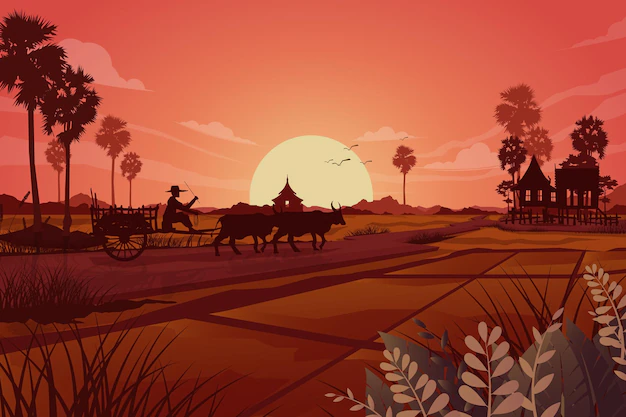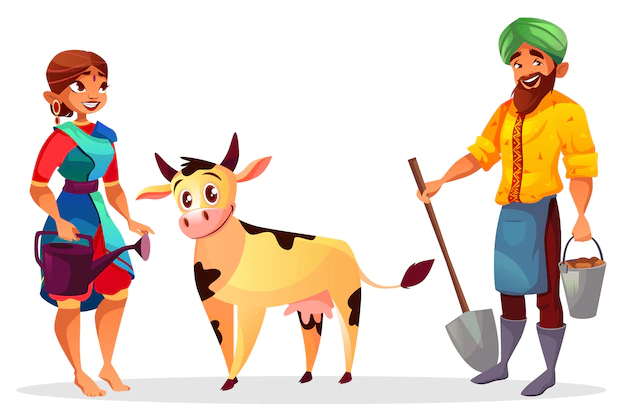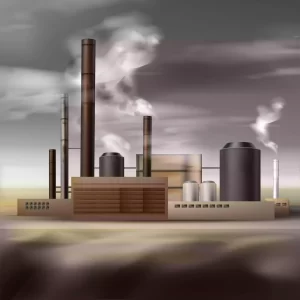Essay on Indian Farmers for Students and Children in English

The Indian farmer is one of the most important people in the world. With a landmass of over 1.3 billion acres, India is one of the world’s largest producers and consumers of food. And it’s not just grains and vegetables that these farmers grow: they also raise cattle, sheep, chickens, and other poultry. In fact, India is home to more than 80% of the world’s chicken population!
This essay will discuss some of the challenges faced by Indian farmers and how they have adapted to overcome them. We will also look at what might be ahead for Indian agriculture in the future and ask whether or not AI will play a role in helping farmers continue producing high-quality food products.
Importance of Farmers
Farmers are the backbone of any country. It is also difficult to imagine life without farmers because they are the ones who deliver food to people’s plates all over the world; in India, about two-thirds of the population is directly or indirectly associated with agriculture. Farmers produce crops, pulses, and vegetables which are needed by all. He works very hard so that he and I can have food on our table every day. So, that’s why we should never waste food, and along with that, we should thank the farmer whenever we eat.
The farmers of India mainly produce pulses, rice, wheat, and spices, and they are also involved in dairy, meat, poultry, fishing, food grains, etc. According to a government survey, agriculture accounts for 20% of India’s GDP, and India has also emerged as the second-largest producer of fruits and vegetables in the world. We should all thank them for their hard work and dedication, and we should do everything we can to support them.
Background of an Indian farmer
Indian farmers are one of the most important groups of agricultural producers in the world. They account for a significant proportion of global food production, and their contribution to human welfare is immeasurable. Indian farmers have been farming for centuries, and their skills and knowledge have been passed down from generation to generation. They have a deep-rooted attachment to their land and produce some of its most nutritious food.
The traditional way of life for Indian farmers is very different from that of modern Westerners. They live in villages, often surrounded by fields, and spend almost all their time working on their farms. They use simple tools and techniques and work closely with their families and neighbours. Indian farmers are often self-sufficient, relying only on the natural resources available to them to produce food. However, they are always looking for ways to improve their productivity and expand their operations.
Indian farmers are essential to the global food supply chain, and their contribution is greatly appreciated by consumers all over the world. Their farms provide us with a wide variety of foods – including fruits, vegetables, grains, pulses, dairy products, meat products, fish products and spices – which we can enjoy without recognizing the source. Indian farmers are also important contributors to environmental health, as they use fewer inputs and generate less waste than modern agricultural practices.
The different crops an Indian farmer grows
In India, there are many different crops an Indian farmer grows. The most common crops an Indian farmer grows are rice, wheat, and maize. An Indian farmer also grows other common crops like cotton, sugarcane, and soybeans.
The reason why the Indian farmer grows so many different crops is that there are a lot of different kinds of soil in India. Some soils are wetter than others, so the Indian farmer grows crops that can grow in those different types of soil. For example, rice can grow in both dry and wet soils, so the Indian farmer grows a lot of rice.
Another reason the Indian farmer grows so many different crops because there are many kinds of people in India. Some people eat primarily vegetarian food while others eat meat, so the Indian farmer grows crops that both types of people can eat. For example, wheat can be eaten as bread or turned into flour to make chapati (flatbread).
The main thing the Indian farmer cares about is making sure his crops will produce enough food to feed his family and help them survive during tough times. He also cares about making sure his crops will be profitable for him.
The process of farming in India
The Indian farmer is hardworking and takes great pride in their work. They are responsible for feeding an estimated 1.3 billion people and account for almost 40% of the world’s agricultural production. The farming process in India is a long and arduous one and requires a lot of dedication and patience on the part of the farmer.
The main crops grown in India are rice, wheat, millet, maize, sugarcane, pulses, vegetables, fruits and cotton. The country has a diverse climate and soil, which means that farmers can grow various crops. However, there are some key challenges that they face. For example, the availability of land is limiting, which means that farmers often have to grow multiple crops on the same piece of land to make money. This can be challenging because it requires good management skills. Additionally, erratic weather patterns can damage crops and cause them to fail.
Despite these challenges, the Indian farmer remains highly productive. Thanks to innovative techniques such as irrigation systems and crop rotation, they can produce high yields. In addition to farming, many Indian farmers also engage in livestock farming. This includes raising cows, sheep, and goats, which are essential for the country’s dairy and meat industries.
The challenges an Indian farmer faces
Since independence in 1947, India has undergone a rapid economic and social transformation. The country is now home to over 1.3 billion people and ranks third in the world in terms of population. With such a high population density, it’s no surprise that India faces many challenges in terms of food production. In fact, the country ranks 131 out of 188 countries on the World Food Programme’s (WFP) Hunger Index, meaning that nearly one in five people suffers from chronic hunger.
Despite India’s impressive growth rate, most of its population still lives in poverty, and this is mainly due to the country’s strained agricultural sector. According to the National Sample Survey Office (NSSO), only 35% of rural households own land, while 73% are dependent on agriculture for their livelihoods. This has led to widespread poverty and malnutrition among India’s rural population.
One of the main problems facing Indian farmers is soil degradation. Over 60% of India’s soils are classified as lost or degraded, leading to low crop yields and increased dependence on external inputs such as fertilisers and pesticides. This problem is compounded by climate change, which is causing more extreme weather conditions such as floods and droughts. As a result, Indian farmers struggle to meet the increasing demand for food products.
Another major challenge faced by Indian farmers is the lack of access to markets. Due to the country’s restrictive trade policies, most agricultural products are not exported and remain in the country, leading to high prices and poor quality. This has led to widespread poverty and malnutrition among India’s rural population.
Finally, Indian farmers face several other challenges, including limited access to irrigation, high production costs, and pests and diseases. These factors have created a critical shortage of farmable land, which has led to increased dependence on external inputs such as fertilisers and pesticides.
The life of an Indian farmer

The life of an Indian farmer is difficult and challenging. They work long hours in the heat, rain, or snow, often without proper clothing or shelter. The conditions on the farms are often harsh, and there is little opportunity for socialization or recreation. Despite the challenges, these farmers continue to produce food for the rest of us.
The Current Condition of the Indian Farmers
The current condition of the Indian farmers is quite alarming. They are facing a lot of challenges due to the poor agricultural policies of the government. The main problem is that they are not getting their due share of subsidies and other financial help from the government. This has forced them to sell their produce at lower prices, which has resulted in a decline in their incomes. In addition, they are also facing problems due to weather conditions and pests. These have caused a lot of damage to their crops, leading to a decrease in their income.
The Indian farmers are also struggling because of the high cost of inputs and other essential items. This is because the prices of these items have increased manifold over the years, making it difficult for them to make a profit from their produce. Apart from this, there are also political issues related to agriculture that need to be addressed. For instance, there is a need to create more jobs in this sector so that farmers can earn a decent living.
Conclusion
The Indian farmer, a hardworking and often forgotten figure in the global food system, plays an integral role in the country’s agricultural production. Most of India’s farmland is rural, where smallholder farmers are predominantly responsible for producing crops that feed India’s population. Despite facing numerous challenges – from poor infrastructure to inadequate access to finance – Indian farmers continue to produce high-quality food products that contribute significantly to the country’s GDP. Their dedication and resilience deserve our appreciation, and their contributions should be considered when developing policies that could improve rural life across India.
Hey kids, how much did you like Essay on Indian Farmers for Students and Children in English? Please share your view in the comment box. Also, please share this story with your friends on social media so they can also enjoy it, and for more such stories, please bookmark storiespub.com.
Suggested Article –
- An Essay on Diwali | Deepawali the Festival of Lights
- 1000 word essay on Mahatma Gandhi in English
- Essay on Environment for the Students in English
- Air Pollution Essay for the Students
- Essay on Child Labor for Students and Children
- Essay on My School for Students
- Essay on Newspaper
- Tree Essay for Students and Children




